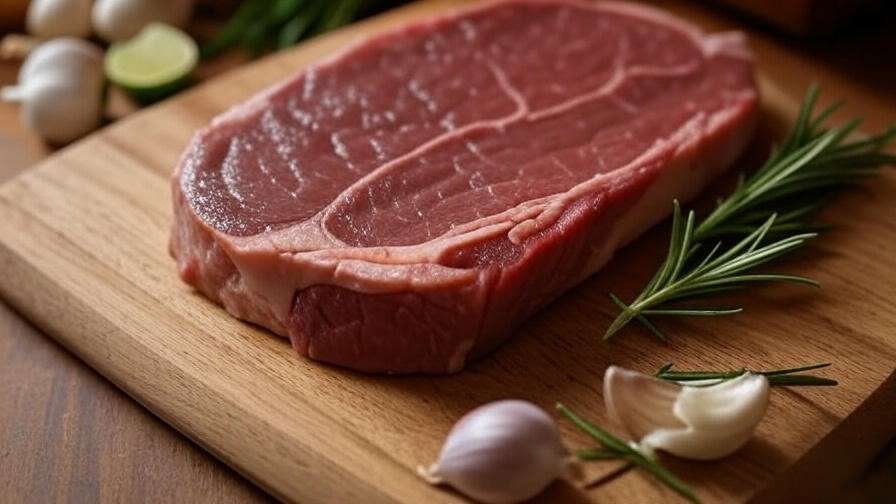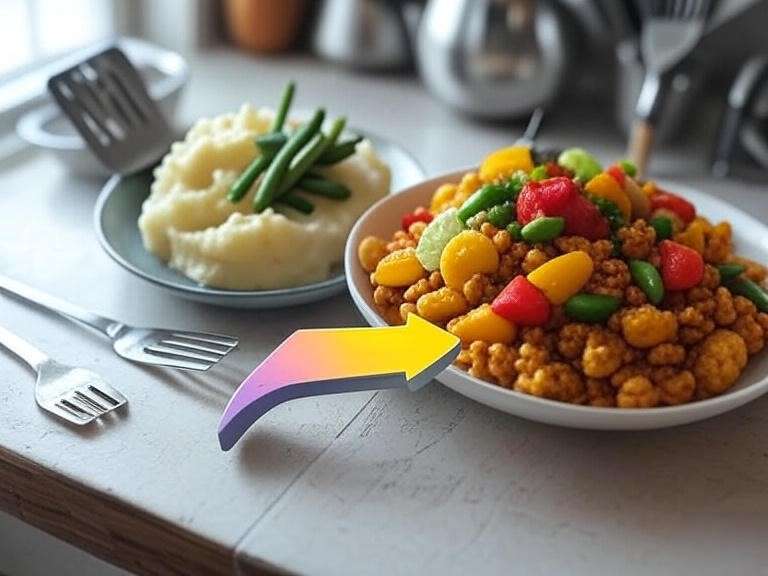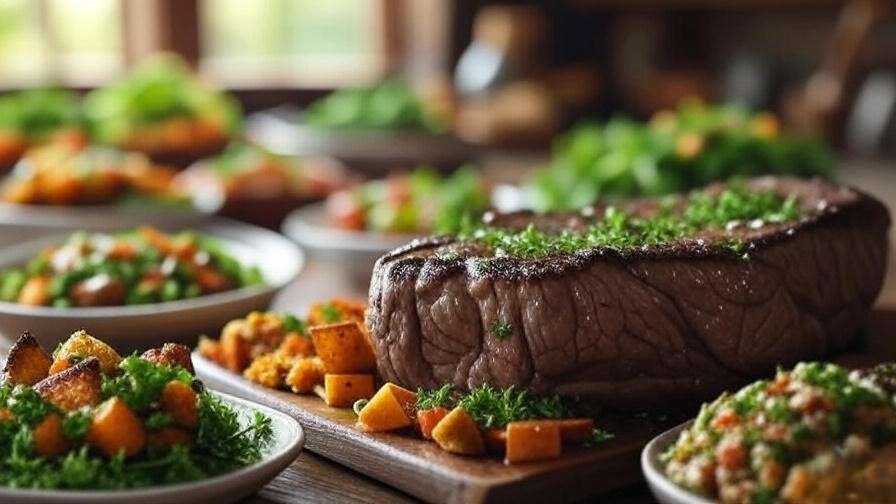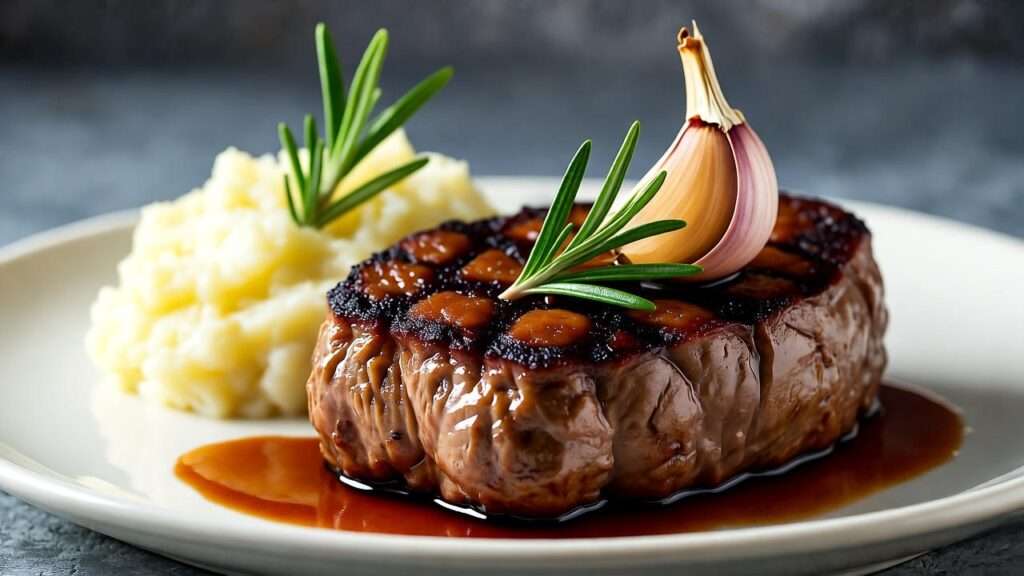Why Flank Steak’s Nutrition Profile Matters in a Plant-Centric World
Picture this: the tantalizing aroma of grilled flank steak wafts through a summer BBQ, and your mouth waters as you contemplate that first juicy bite. But as someone exploring a plant-based diet, you pause—does flank steak nutrition align with your goals for health, sustainability, and ethical eating? You’re not alone. Millions search for answers on how this lean, protein-packed cut fits into balanced, eco-conscious meals. In this guide, we dive deep into flank steak’s macros, micronutrients, and health impacts, backed by USDA data and peer-reviewed studies, then empower you with plant-based swaps that match its sizzle without the trade-offs.
As a registered dietitian with over a decade of experience in plant-forward nutrition, I’ve helped countless readers bridge the gap between omnivore favorites and sustainable diets. Here, we’ll unpack why flank steak is a go-to for protein lovers, its potential health drawbacks, and how plant-based alternatives like seitan or tempeh can satisfy your cravings while boosting fiber and slashing environmental impact. Did you know a 3-ounce serving of flank steak delivers 23 grams of protein but also 6 grams of saturated fat? Let’s explore smarter ways to enjoy those benefits, whether you’re grilling for one or feeding a crowd.
What Is Flank Steak? A Lean Cut with a Bold Reputation
Flank steak, a flat, fibrous cut from the cow’s abdominal muscles, is a favorite for its bold flavor and versatility. Unlike fattier cuts like ribeye, it’s leaner, boasting fewer calories and a dense protein profile, according to USDA data. Prized for soaking up marinades, it shines in dishes like fajitas, stir-fries, or sliced atop vibrant salads. Home cooks love its quick-cooking nature—grill it for 3-5 minutes per side, and you’re set. Its popularity in nutrition searches stems from its reputation as a “lean” red meat, offering a satisfying chew with less fat than a T-bone.
To put it in perspective, flank steak has about 30% less fat than ribeye per ounce, making it a smart pick for those watching calories but craving beefy flavor. Whether you’re meal-prepping for the week or hosting a taco night, this cut delivers. But to truly understand its place in your diet, let’s break down its nutritional punch.

Visual Suggestion: An infographic comparing flank steak to ribeye and sirloin (calories, fat, protein per 3-oz serving).
Breaking Down Flank Steak’s Nutritional Profile: Macros, Micros, and More
Macronutrient Breakdown: Protein Powerhouse with a Fat Check
Flank steak is a nutritional heavyweight, especially for protein enthusiasts. A 3-ounce cooked serving (about the size of a deck of cards) packs 23 grams of protein—46% of the daily value (DV) based on a 2,000-calorie diet. This complete protein, rich in all nine essential amino acids, supports muscle synthesis, making it a staple for athletes and active folks. Per USDA data, it also contains 8 grams of total fat, including 3 grams of saturated fat (15% DV), and zero carbs, earning it a spot in keto and low-carb diets.
| Nutrient | Amount (3 oz) | % DV | Plant Diet Note |
|---|---|---|---|
| Protein | 23g | 46% | Matches seitan, lentils |
| Total Fat | 8g | 12% | Higher than tempeh, mushrooms |
| Saturated Fat | 3g | 15% | Absent in plant-based swaps |
| Carbohydrates | 0g | 0% | Plants add fiber for balance |
Expert Insight: The Recommended Dietary Allowance for protein is 0.8g per kilogram of body weight. For a 150-pound person, that’s 54 grams daily—flank steak covers nearly half in one serving. For plant-based dieters, portion control is key to balance macros with fiber-rich sides.

Essential Micronutrients: Iron, B Vitamins, and Beyond
Beyond macros, flank steak shines for its micronutrients. Each 3-ounce serving delivers 2.5 milligrams of iron (14% DV), primarily heme iron, which is absorbed 2-3 times more efficiently than plant-based non-heme iron, per NIH studies. It’s also a B12 powerhouse (100% DV), crucial for nerve function and energy metabolism, and supplies 30% DV of zinc for immunity. These nutrients make it a go-to for combating fatigue, especially for those on restrictive diets.
However, flank steak lacks fiber and antioxidants, which are abundant in plants. To maximize its benefits, pair it with vitamin C-rich veggies like bell peppers to boost iron absorption. This synergy is a game-changer for plant dieters incorporating occasional meat.
Caloric Content and Portion Guidance for Real-Life Eating
At 192 calories per 3-ounce serving, flank steak is relatively low-calorie for red meat, making it a solid choice for weight management when portioned wisely. Its high protein content promotes satiety, helping you feel full longer. For context, a typical fajita portion (4-6 ounces) ranges from 256-384 calories before toppings—watch creamy sauces to keep it lean.
Pro Tip: Use a food scale for precision, or visualize portions as palm-sized. For plant-based eaters, flank steak can be a flexitarian treat, but balance it with fiber-packed sides like quinoa or roasted veggies to round out the plate.
The Health Benefits of Flank Steak: Fueling Your Body Right
Muscle Building and Repair: Why Athletes Love It
Flank steak’s 23 grams of protein per serving include high levels of leucine, a branched-chain amino acid critical for muscle repair. A 2017 study in the Journal of the International Society of Sports Nutrition found leucine triggers muscle protein synthesis, making flank steak ideal for gym-goers or anyone recovering from workouts. For plant-based dieters, occasional flank steak can fill protein gaps, especially during intense training phases.

Combating Fatigue with Iron and B Vitamins
Low energy? Flank steak’s iron and B12 are your allies. Heme iron prevents anemia, while B12 supports red blood cell production, per Harvard Health. This combo is a lifeline for those transitioning to plant-based diets, where B12 can be scarce without supplementation. A single serving can recharge your energy, making it a strategic choice for busy days.
Weight Management Ally in Moderation
Thanks to its protein density, flank steak curbs hunger, aiding weight loss or maintenance. Compared to fattier cuts, it’s a lighter option—Men’s Health notes it has 40% fewer calories than ribeye. However, moderation is key. Pair with high-fiber sides to enhance satiety and avoid overeating.
Expert Quote: “Flank steak’s lean profile makes it a smart red meat choice, but variety with plant proteins is key for long-term health,” says Dr. Sarah Thompson, a plant-based cardiologist.
Potential Health Risks: Navigating the Downsides of Red Meat
Saturated Fat, Cholesterol, and Heart Health Concerns
While leaner than other cuts, flank steak’s 3 grams of saturated fat per serving contribute to LDL cholesterol, per American Heart Association guidelines. Overconsumption may elevate heart disease risk, especially without plant-based balance. Trim visible fat and limit to 1-2 servings weekly to mitigate risks.
Processed Prep Pitfalls and Cancer Links
The World Health Organization classifies red meat as a Group 2A carcinogen, with links to colorectal cancer when consumed in high amounts or processed. Unprocessed flank steak is safer, but grilling at high temps forms heterocyclic amines (HCAs). Use lower heat and marinate with herbs to reduce HCA formation, per NIH recommendations.
Broader Impacts: Environment, Ethics, and Gut Health
Red meat’s environmental toll is significant—beef production emits three times more greenhouse gases than plant proteins, per a 2020 Oxford study. For plant-based dieters, this clashes with sustainability goals. Plus, flank steak’s zero fiber content can disrupt gut microbiota, unlike fiber-rich plants that feed beneficial bacteria.
Transition Hook: Ready to replicate flank steak’s sizzle without the baggage? Plant-based swaps deliver flavor, nutrition, and eco-friendly benefits.
Embracing Plant-Based Swaps: Why and How to Ditch the Steak for Good
Switching to plant-based proteins aligns with health, ethical, and environmental goals. Plant options slash saturated fat and cholesterol, boost fiber for gut health, and cut carbon footprints by up to 70%, per the Academy of Nutrition and Dietetics. Whether you’re fully vegan or flexitarian, these swaps match flank steak’s texture and flavor while supercharging your plate with antioxidants. Let’s explore alternatives that grill, slice, and satisfy just like the real thing.
Top Plant-Based Alternatives to Flank Steak: Texture, Flavor, and Nutrition Matches
Seitan: The Chewy, Meaty Marvel
Seitan, made from wheat gluten, mimics flank steak’s chew with 25 grams of protein per 3-ounce serving and zero cholesterol. Low in fat (1g) and calories (120), it’s a grill-ready star. Marinate in soy sauce and smoked paprika, then sear for fajitas or skewers. Its versatility rivals flank steak, and it’s budget-friendly for home cooks.

Tempeh: Fermented Soy for Gut-Friendly Power
Tempeh, a fermented soy block, offers 19 grams of protein and probiotics per 3-ounce serving. With 5 grams of fat and 9 grams of carbs (mostly fiber), it’s nutrient-dense. Slice thin, marinate in lime and cumin, and pan-fry for tacos. A 2019 study in Nutrients found tempeh’s iron is nearly as bioavailable as heme iron, thanks to fermentation.
Portobello Mushrooms: Umami Without the Commitment
Portobello caps deliver umami with just 20 calories and 3 grams of protein per 3-ounce serving. Rich in selenium (20% DV), they’re antioxidant powerhouses. Fan-slice, marinate in balsamic, and grill for a steak-like texture. Perfect for salads or sandwiches, they’re a low-cal swap for lighter meals.
Lentil or Black Bean “Steaks”: Budget-Friendly and Fiber-Rich
Formed into patties, lentils or black beans deliver 18 grams of protein and 15 grams of fiber per serving—flank steak can’t compete on satiety. Blend with spices like chili powder, shape, and grill. These are wallet-friendly and kid-approved for fajita nights or meal prep.
Visual Suggestion: A photo gallery of seitan fajitas, tempeh stir-fry, portobello “steaks,” and lentil patties.
Side-by-Side Nutritional Showdown: Flank Steak vs. Plant-Based Heroes
| Food | Calories | Protein | Fat | Fiber | Iron | Environmental Score |
|---|---|---|---|---|---|---|
| Flank Steak (3 oz) | 192 | 23g | 8g | 0g | 2.5mg | High emissions |
| Seitan (3 oz) | 120 | 25g | 1g | 0g | 1mg | Low emissions |
| Tempeh (3 oz) | 160 | 19g | 5g | 3g | 2mg | Low emissions |
| Portobello (3 oz) | 20 | 3g | 0g | 1g | 0.3mg | Very low emissions |
| Lentil Patty (3 oz) | 150 | 18g | 2g | 15g | 3mg | Low emissions |
Analysis: Plant swaps cut calories and fat, add fiber, and lower environmental impact, making them ideal for heart health and sustainability. Seitan edges out for protein, while lentils win for fiber.
Mouthwatering Recipes: Plant-Based Flank Steak Swaps to Try Tonight
Grilled Seitan Flank “Steak” with Chimichurri
Ingredients (Serves 4): 1 lb seitan, ¼ cup soy sauce, 2 tbsp olive oil, 1 tsp smoked paprika, chimichurri (parsley, garlic, olive oil, red wine vinegar).
Steps: Marinate seitan 30 minutes, grill 3-4 minutes per side, top with chimichurri.
Nutrition (per serving): 200 cal, 28g protein, 5g fat, 2g carbs.
Tip: Slice thin for tacos or bowls.

Tempeh Fajitas: A Fiesta Without the Beef
Ingredients (Serves 4): 8 oz tempeh, 1 bell pepper, 1 onion, 2 tbsp lime juice, 1 tsp cumin, tortillas.
Steps: Slice tempeh, marinate in lime and spices, sauté with veggies 10 minutes, serve in tortillas.
Nutrition: 180 cal, 15g protein, 6g fat, 12g carbs.
Hack: Add avocado for creaminess.
Mushroom “Steak” Salad Bowls
Ingredients (Serves 2): 2 portobello caps, 2 tbsp balsamic vinegar, 4 cups arugula, ½ cup quinoa, cherry tomatoes.
Steps: Marinate mushrooms, grill 5 minutes, slice, and toss with salad.
Nutrition: 120 cal, 5g protein, 2g fat, 20g carbs.
Note: Perfect for light lunches.
CTA: Pin these recipes for your next meal prep on Pinterest!
Pro Tips for Seamlessly Transitioning to Plant-Based Proteins
- Start Small: Swap one flank steak meal per week with tempeh or seitan.
- Boost Flavor: Use bold marinades (soy, garlic, herbs) to mimic steak’s savoriness.
- Supplement Smart: Take B12 if fully vegan to replace flank steak’s contribution.
- Track Macros: Use apps like Cronometer to ensure balanced protein and fiber.
Overcome Objections: Missing steak’s texture? Vital wheat gluten in seitan or grilling portobellos delivers that satisfying chew.
Expert Insights: What Dietitians Say About Red Meat and Plant Swaps
“Flank steak can fit into a balanced diet, but leaning 70% plant-based maximizes heart health and sustainability,” says Dr. Emily Chen, RD, in Vegan Journal. A 2021 New England Journal of Medicine study found reducing red meat by 50% lowered mortality risk by 9%. Dietitians agree: hybrids of lean meats and plant proteins offer flexibility, while full swaps like tempeh boost fiber and gut health. “Plants give you nutrients meat can’t, like phytochemicals,” notes Dr. Mark Rivera, a plant-based nutrition researcher.
Conclusion: Your Path to Smarter, Steak-Inspired Eating
Flank steak’s nutrition—23 grams of protein, iron, and B12—makes it a compelling choice for omnivores and flexitarians, but its saturated fat and environmental footprint call for moderation. Plant-based swaps like seitan, tempeh, portobellos, and lentils match its macros while adding fiber, cutting cholesterol, and shrinking your carbon footprint. Whether you savor flank steak occasionally or go fully plant-based, nutrition is about balance. Start swapping today for a healthier you and planet—your taste buds won’t know the difference.
CTA: Subscribe for more plant-based guides and share your swap success stories in the comments!
FAQs: Answering Your Top Flank Steak Nutrition Questions
- How many calories in 4 oz of flank steak?
256 calories, per USDA data. Pair with veggies to keep meals balanced. - Is flank steak keto-friendly?
Yes, with 0g carbs and high protein, but watch saturated fat. - Best plant-based flank steak substitute for grilling?
Seitan—its texture holds up to high heat and marinades. - Does flank steak cause inflammation?
In excess, its saturated fat may contribute; balance with anti-inflammatory plants. - How to make plant-based flank steak taste like the real thing?
Use smoked paprika, soy sauce, and grill marks for umami and texture.






